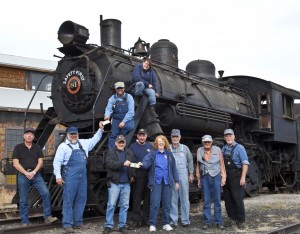From left to right on the ground Gary North, Steam Locomotive Restorer, Mark Bassett, Executive Director, Gledhill, Henry Stewart, Shop Foreman, Joan Bassett, Curator, Gary Hansen, Shop Mechanic, Bob Dallons, Volunteer and Terry Fletcher, Volunteer. Upper row left to right, DeBellis, Angie Cracraft Shop Mechanic.
For the first time in twenty-four years, Nevada Northern Railway Locomotive 81 was once again outdoors. On October 23rd, Locomotive 81 was moved from the Enginehouse to the RIP Building to begin a two-year restoration project with the goal of having Locomotive 81 in service for the 2017 excursion season.
Locomotive 81 is our “Goldilocks” locomotive. Locomotive 93 is too big for what we do and Locomotive 40 is too small for what we do. Meanwhile Locomotive 81 is just right. Locomotive 81 is also our “newest” locomotive. She was built and delivered to the Nevada Northern Railway in March 1917. Of course, “newest” is a relative term here; Locomotive 81 is only seven years younger than Locomotive 40 and eight years younger than Locomotive 93. But those eight years brought major improvements to steam locomotives and Locomotive 81 was delivered with all of the latest (for the time) technology.

Restoring Locomotive 81 will allow the museum to take advantage of this latest technology. What does this mean? Because of the improvements that Locomotive 81 received over our other locomotives, this should equate to lower operating costs for the Museum. The same holds true today, as it did a century ago; businesses are always trying to lower operating costs. The Museum is no different; we need to stretch every dollar. The restoration of Locomotive 81 will not be inexpensive. It is budgeted at $1,200,000. So why does the museum need a third steam locomotive in operation?

Steam locomotives are required by the Federal Railroad Administration (FRA) to undergo a fifteen-year maintenance cycle.
Newmont Notes Double click on the thumbnail/image
Locomotive 93 will need to go under this federally mandated maintenance cycle staring in October 2016. As part of this maintenance cycle, the tubes in Locomotive 93’s boiler will need to be removed and the boiler shell inspected. In addition to the boiler work, the locomotive and her tender will be examined closely. Considering that the locomotive will be 107 years old in 2016, I can almost guarantee that we will find other issues that will need to be repaired during the fifteen-year maintenance cycle. This will put Locomotive 93 out of service for the 2017 operating season. If Locomotive 81 is not in service for the 2017 season that will leave Locomotive 40, a 107 year-old locomotive, to handle all of the trips that year.
Depending on Locomotive 40 to handle the 2017 season by herself is a recipe for a financial disaster for the Museum. We already know that Locomotive 40’s running gear has issues that date back to the 1930s. And, at any time, these issues could sideline Locomotive 40 for months if not years. That would leave us with no steam for the 2017 season and that would be disastrous.
When I first became the Executive Director in 2002, I thought that people came to Ely to ride our trains and it didn’t matter what was pulling those trains. The staff at the time tried to tell me differently. It turns out that they were right and I was wrong. The fact of the matter is, to attract people to Ely Nevada, to ride our trains, we need to have the steam locomotives in operation. If a person is going to commit to making a 500 mile, 1,000 mile, or further round trip; then they want to see one of our steam locomotives in operation. It’s as simple as that.
How do we know this? In 2008, the museum went through the season without an operating steam locomotive and it nearly killed us. Our ridership dropped by almost a third. That drop in ridership equated to losing more than $140,000 in revenue for that year. To avoid having such a calamity happen again, the Museum is being proactive by beginning the restoration of Locomotive 81 before she is needed for our excursion trains.
Will the Locomotive 81 project be a huge project? Yes! Is $1,200,000 a lot of money to raise? You bet it is! Can the Museum successfully restore Locomotive 81? Again the answer is yes. Both Locomotive 81 and 93 sat at the White Pine Public Museum for 30 years exposed to the weather. Today Locomotive 93 is in service.
The Museum has a track record of undertaking projects of this scale and successfully completing them. Since 1996, the Museum has raised and invested $17,466,140 in the complex. The Locomotive 81 project is just the start of a proactive program to raise money to ensure that all of our steam locomotives stay in service. How
are we going to do this?
The museum has started the Phoenix Projects Program. From mythology, a Phoenix is a long-lived bird that is cyclically regenerated or reborn, a phoenix typically dies by fire and raises from the ashes. The symbology of a Phoenix, fits a steam locomotive to a ‘T’.
Steam locomotives go through the same cycle as a Phoenix. A steam locomotive’s service cycle is fifteen years. At the end of this cycle, a steam locomotive is removed from service or you could say that it dies. Paradoxically, a Phoenix and a steam locomotive both die because of fire! Every time we light a fire in a steam locomotive, we are using it up. But, just like a Phoenix, a steam locomotive can be regenerated or reborn to begin the cycle all over again!
The Museum’s Phoenix Projects Program is designed to address operating our steam locomotives for the long term. Locomotive 81 will be the first to undergo a restoration under this program. As part of Locomotive 81’s restoration, we will be doing Locomotive 3; a small steam locomotive that operated in McGill. There are significant savings in costs to restore Locomotive 3 at the same time as Locomotive 81. The successful restoration of Locomotive 3 will give us a small steam locomotive that is inexpensive to operate.
With Locomotive 81 back in service by its centennial in 2017, Locomotive 93 will then go into the shop for its fifteen-year maintenance cycle. Depending on what we find on Locomotive 93, it should be out-of-service for 12-18 months. The estimated cost for Locomotive 93 is $500,000. Locomotive 93 should be back in service by late 2018. Then it will be Locomotive 40’s turn.
Locomotive 40 will need a complete overhaul: boiler, running gear and tender. Most likely, Locomotive 40 will be the most expensive of the four locomotives to restore. The cost of Locomotive 40’s restoration is estimated at $1,500,000.
One of the goals of the Phoenix Project is to get all four of our steam locomotives in top-notch shape by 2020. The cost to do this is somewhere between $3,500,000 and $4,000,000.
Yes, that is a lot of money. But operating and maintaining the steam locomotives are vital to the continued success of the Museum and tourism in White Pine County. Thirty years ago, when the Museum was created, there was a belief that the Nevada Northern Railway could serve as an economic engine (pardon the pun) for White Pine County. The railroad has lived up to that belief.
Since operations began in 1987, the railroad has carried almost a quarter of a million passengers! Those passengers have spent an estimated $60,000,000 in White Pine County! That’s the reason why the success of the Phoenix Projects is so important to, not only the railroad, but also to our community. The Phoenix Project will ensure that steam locomotives will stay in operation in White Pine County for the foreseeable future. The restoration of Locomotive 81 is the first step in that ambitious goal. As the project moves along, I’ll keep you updated.




